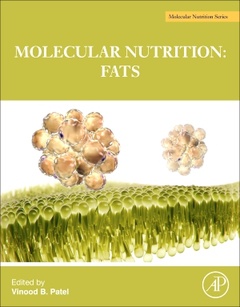Description
The Molecular Nutrition of Fats
An Analysis of Implications on Cells to Public Health
Coordinator: Patel Vinood
Language: English
Subject for The Molecular Nutrition of Fats:
Keywords
ß-oxidation; 4-Hydroxynonenal; Acetyl-CoA; Acrolein; Adipogenesis; Adipokines; Adipose precursor; Adipose tissue; Adipose; Algal oil; Anticonvulsant; Apo(a)Cardiovascular disease; Apolipoproteins; Apoptosis; Asymmetry; Atherosclerosis; Behavior disorders; Browning; Cardiovascular disease; Cardiovascular risk; Central nervous system; Ceramides; Cholesterol absorption; Cholesterol; Chylomicron; Classes; C-Reactive protein; Curcumin; Cyclosporin A; Cytoplasmic lipid droplet; Diacylglycerol; Diet; D
470 p. · 21.4x27.6 cm · Paperback
Description
/li>Contents
/li>Readership
/li>Biography
/li>Comment
/li>
The Molecular Nutrition of Fats presents the nutritional and molecular aspects of fats by assessing their dietary components, their structural and metabolic effects on the cell, and their role in health and disease. Subject areas include molecular mechanisms, membranes, polymorphisms, SNPs, genomic wide analysis, genotypes, gene expression, genetic modifications and other aspects. The book is divided into three sections, providing information on the general and introductory aspects, the molecular biology of the cell, and the genetic machinery and its function. Topics discussed include lipid-related molecules, dietary lipids and lipid metabolism, high fat diets, choline, cholesterol, membranes, trans-and saturated fatty acids, and lipid rafts.
Other sections provide comprehensive discussions on G protein-coupled receptors, micro RNA, transcriptomics, transcriptional factors, cholesterol, triacylglycerols, beta-oxidation, cholesteryl ester transfer, beta-oxidation, lysosomes, lipid droplets, insulin mTOR signaling and ligands, and more.
Section 1: General and Introductory Aspects 1. Intestinal health and bioactive lipids 2. C-reactive protein and plasma fatty acids: public health concerns and implications 3. The role of a fatty acid chain elongase, Elovl,1 in zebrafish and implications fcor human kidney 4. Dietary lipids and lipid metabolism: An overview 5. Fatty acids use in neurological disease 6. The Neurocan-cartilage intermediate layer protein NCAN-CILP2 region and plasma lipid levels 7. Role of cholesterol on controlling membrane phospholipid asymmetry 8. Adipose tissue and peritoneal dialysis 9. Lipid biomarkers and cancer 10. Absorption of dietary fat and their metabolism in enterocytes 11. The lipid-lowering action of iodothyronines 12. Dietary Omega-3s and Muscle Composition in adults 13. An overview of cholesterol absorption 14. Triacylglycerols and use of docosahexaenoic acid at the sn-2 position 15. Safety of Docosahexaenoic acid (DHA) ethyl ester and implications for human studies 16. Fish oil supplementation and depression 17. Drugs to counter SFA-mediated lipointoxication 18. Lipoprotein (a) [Lp(a)] 19. Endoplasmic reticulum (ER) stress, and white adipose tissue lipolysis 20. Trans-fat intake and behaviour 21. Glycemic index meal feeding and lipid profiling 22. Beef Fat 23. Lipid pathway in liver cells and its modulation by dietary extracts
Section 2: Molecular Biology of the Cell 24. Subcellular organelles: lipid droplets 25. Optimized omega-3 EPA:DHA 6:1 and pulmonary arterial hypertension 26. Omega-3 fatty acids and epilepsy 27. Docosahexaenoic acid (DHA): A dietary supplement with promising anticancer potential 28. Periaortic adipose tissue in obesogenic diets 29. Genomics, statins and lipid metabolism 30. Cholesterol metabolism in atherosclerosis development 31. Lipid metabolism in dyslipidemia and familial hypercholesterolemia 32. Lipid Profile of Progenitor Cells 33. Trans-fatty acids and mortality 34. Saturated and monounsaturated fatty acids associate with development and prematurity 35. Hedgehog signaling and liver lipid metabolism 36. Cyclosporin A-Induced Dyslipidemia and LDL Receptors 37. Hypoxia and adipose tissue lipid breakdown 38. Intramyocellular fat storage
Section 3: Genetic Machinery and Its Function 39. Fatty acid binding protein 2 genes and public health implications for diabetes 40. Transcriptional factor modulation by lipid peroxidation-derived aldehydes 41. Heterogeneity of white adipose tissue 42. Nomenclature, classes and functions of lipids and lipid-related molecules, Dietary lipids 43. Lipid metabolism: an overview - The mitochondria as a site of fatty acid beta-oxidation 44. Fatty acids, gut bacteria and immune cell function
Researchers, professionals (including nutritionists, dieticians, health scientists, health care professionals, policy makers), educators, and students
- Summarizes molecular nutrition in health as related to fats
- Discusses the impact of fats on cancer, heart disease, dementia, and respiratory and intestinal disease
- Includes preclinical, clinical and population studies
- Covers the genome, the whole body and whole communities
- Includes key facts, a mini dictionary of terms and summary points

